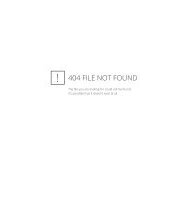View Transcript - Hopkins CME Blog
View Transcript - Hopkins CME Blog
View Transcript - Hopkins CME Blog
Create successful ePaper yourself
Turn your PDF publications into a flip-book with our unique Google optimized e-Paper software.
HOME <strong>CME</strong>/CE INFORMATION PROGRAM DIRECTORS NEWSLETTER ARCHIVE EDIT PROFILE RECOMMEND TO A COLLEAGUE<br />
voLUME 9 — iSSUE 14: TRANScRipT<br />
Featured Cases: Optimizing Nutritional Support with Protein and<br />
Energy for Very Low Birth Weight Infants<br />
Our guest author is David H. Adamkin, Professor of<br />
Pediatrics, Director of the Division of Neonatal<br />
Medicine, and Rounsavall Endowed Chair of<br />
Neonatology at the University of Louisville.<br />
After participating in this activity, the participant will<br />
demonstrate the ability to:<br />
n Describe the importance of starting parenteral<br />
nutrition in the first hours of life, even in the face<br />
of critical illness in VLBW infants,<br />
n Evaluate the role of parenteral amino acids in<br />
glycemic control, as well as lipids in relation to lung<br />
dysfunction, in VLBW infants, and<br />
n Discuss the role of donor-fortified milk in VLBW<br />
infants.<br />
This discussion, offered as a downloadable audio file<br />
and companion transcript, covers the important issues<br />
related to enhancing nutrition in very low birth weight<br />
infants in the format of case-study scenarios for the<br />
clinical practice. This program is a follow up to the<br />
Volume 9, Issue 13 eNeonatal Review newsletter—<br />
Optimizing Nutritional Support with Protein and Energy<br />
for Very Low Birth Weight Infants.<br />
MEET ThE AUThoR<br />
David H. Adamkin, MD<br />
Professor of Pediatrics<br />
Director, Division of Neonatal<br />
Medicine<br />
Rounsavall Endowed Chair of<br />
Neonatology<br />
University of Louisville<br />
Louisville, Kentucky<br />
Guest Faculty Disclosure<br />
The author has indicated that he has no financial<br />
interests or relationships with a commercial entity<br />
whose products or services are relevant to the<br />
content of his presentation.<br />
Unlabeled/Unapproved Uses<br />
The author has indicated that there will be no<br />
references to unlabeled/unapproved uses of drugs<br />
or products.<br />
Release Date<br />
October 31, 2013<br />
Expiration Date<br />
October 30, 2015<br />
pRoGRAM DiREcToRS<br />
Edward E. Lawson, MD<br />
Professor of Pediatrics<br />
Johns <strong>Hopkins</strong> University<br />
School of Medicine<br />
Chief, Division of<br />
Neonatology<br />
Vice Chair, Department of<br />
Pediatrics Johns <strong>Hopkins</strong><br />
Children’s Center<br />
Baltimore, Maryland<br />
Maureen M. Gilmore, MD<br />
Assistant Professor of<br />
Pediatrics<br />
Director of Neonatology<br />
Johns <strong>Hopkins</strong> Bayview<br />
Medical Center<br />
Baltimore, Maryland<br />
Lawrence M. Nogee, MD<br />
Professor<br />
Department of Pediatrics<br />
Division of Neonatology<br />
The Johns <strong>Hopkins</strong><br />
University School of<br />
Medicine<br />
Baltimore, Maryland<br />
Mary Terhaar, DNSc, RN<br />
Assistant Professor<br />
Undergraduate Instruction<br />
The Johns <strong>Hopkins</strong><br />
University School of<br />
Nursing<br />
Baltimore, Maryland<br />
Anthony Bilenki, MA, RRT<br />
Technical Director<br />
Respiratory Care Services<br />
Division of Anesthesiology<br />
and Critical Care Medicine<br />
The Johns <strong>Hopkins</strong><br />
Hospital<br />
Baltimore, Maryland
cME/cE iNFoRMATioN<br />
_<br />
pRoGRAM BEGiNS BELow<br />
AccREDiTATioN STATEMENTS<br />
physicians<br />
This activity has been planned and implemented in accordance with the Essential Areas and<br />
Policies of the Accreditation Council for Continuing Medical Education through the joint<br />
sponsorship of the Johns <strong>Hopkins</strong> University School of Medicine and The Institute for Johns<br />
<strong>Hopkins</strong> Nursing. The Johns <strong>Hopkins</strong> University School of Medicine is accredited by the<br />
AC<strong>CME</strong> to provide continuing medical education for physicians.<br />
Nurses<br />
The Institute for Johns <strong>Hopkins</strong> Nursing is accredited as a provider of continuing nursing<br />
education by the American Nurses Credentialing Center's Commission on Accreditation.<br />
The Institute for Johns <strong>Hopkins</strong> Nursing and the American Nurses Credentialing Center do not<br />
endorse the use of any commercial products discussed or displayed in conjunction with this<br />
educational activity<br />
Respiratory Therapists<br />
Respiratory therapists should visit this page to confirm that AMA PRA Category 1 Credit(s)<br />
are accepted toward fulfillment of RT requirements.<br />
cREDiT DESiGNATioNS<br />
physicians<br />
eNewsletter: The Johns <strong>Hopkins</strong> University School of Medicine designates this enduring<br />
material for a maximum of 1.0 AMA PRA Category 1 Credit. Physicians should claim only the<br />
credit commensurate with the extent of their participation in the activity.<br />
Podcast: The Johns <strong>Hopkins</strong> University School of Medicine designates this enduring material<br />
for a maximum of 0.5 AMA PRA Category 1 Credits(s). Physicians should claim only the<br />
credit commensurate with the extent of their participation in the activity.<br />
Nurses<br />
eNewsletter: The 1 contact hour educational activity is provided by The Institute for Johns<br />
<strong>Hopkins</strong> Nursing. Each newsletter carries a maximum of 1 contact hour or a total of 8 contact<br />
hours for the eight newsletters in this program.<br />
Podcast: This 0.5 contact hour educational activity is provided by The Institute for Johns<br />
<strong>Hopkins</strong> Nursing. Each podcast carries a maximum of 0.5 contact hours or a total of 4 contact<br />
hours for the eight podcasts in this program.<br />
To obtain contact hours, you must complete this Educational Activity and post-test by<br />
October 30, 2015.<br />
Respiratory Therapy<br />
For United States: Visit this page to confirm that your state will accept the CE Credits gained<br />
through this program.<br />
For Canada: Visit this page to confirm that your province will accept the CE Credits gained<br />
through this program.<br />
SUccESSFUL coMpLETioN<br />
To successfully complete this activity, participants must read the content, and then link to the<br />
Johns <strong>Hopkins</strong> University School of Medicine's <strong>CME</strong> website, or the Institute for Johns <strong>Hopkins</strong><br />
Nursing to complete the post–test and evaluation. Once you receive a passing grade, you can<br />
access and print your certificate of credit.<br />
NOTE: If you have already registered for other <strong>Hopkins</strong> <strong>CME</strong> programs on their prospective<br />
websites simply enter the requested information when prompted.<br />
There are no fees or prerequisites for this activity.<br />
This activity is supported by educational grants from Abbott Nutrition, Cornerstone<br />
Pharmaceuticals, Ikaria, and Mead Johnson Nutrition.<br />
LAUNch DATE<br />
June 21, 2012; activities expire two years from the date of each publication.<br />
iNTERNET cME poLicy<br />
The Office of Continuing Medical Education (O<strong>CME</strong>) at the Johns <strong>Hopkins</strong> University School of<br />
Medicine is committed to protecting the privacy of its members and customers. Johns <strong>Hopkins</strong><br />
University SOM <strong>CME</strong> maintains its Internet site as an information resource and service for<br />
physicians, other health professionals and the public.<br />
Continuing Medical Education at the Johns <strong>Hopkins</strong> University School of Medicine will keep<br />
your personal and credit information confidential when you participate in a <strong>CME</strong> Internet–<br />
based program. Your information will never be given to anyone outside of the Johns <strong>Hopkins</strong><br />
University School of Medicine's <strong>CME</strong> program. <strong>CME</strong> collects only the information necessary to<br />
provide you with the services that you request.<br />
DiScLAiMER STATEMENT<br />
The opinions and recommendations expressed by faculty and other experts whose input is<br />
included in this program are their own. This enduring material is produced for educational<br />
purposes only. Use of the Johns <strong>Hopkins</strong> University School of Medicine name implies a review<br />
of educational format, design, and approach. Please review the complete prescribing<br />
information of specific drugs or combination of drugs, including indications, contraindications,<br />
warnings, and adverse effects, before administering pharmacologic therapy to patients.<br />
STATEMENT oF RESpoNSiBiLiTy<br />
The Johns <strong>Hopkins</strong> University School of Medicine takes responsibility for the content, quality,<br />
and scientific integrity of this <strong>CME</strong> activity.<br />
STATEMENT oF NEED<br />
Through discussions with expert physician/educators, a survey of practicing neonatologists,<br />
and a review of the current literature, including national and regional guidelines and quality-ofcare<br />
measures, the following core learning gaps have been identified:<br />
n In addition to cognitive, educational, and behavioral impairments later in life, former<br />
premature infants with BPD also suffer higher rates of long-term airway obstruction and<br />
mild exercise intolerance, potentially preventable with better NICU and post-discharge care.<br />
n Protocols for noninvasive methods of pulmonary support are underused or misused in<br />
many neonatal care settings, resulting in higher rates of lung injury in preterm infants from<br />
mechanical ventilation.<br />
n Neonatologists need a consistent and precise approach to the diagnosis and treatment of<br />
ventilator-acquired pneumonia (VAP) to minimize ineffective empiric antibiotic treatment.<br />
n Although major reductions in the burden of CLABSI in NICUs have been achieved, variable<br />
rates of sepsis in different NICUs indicate that adherence to best practices and vigilant<br />
preventive interventions are not as uniform as they could and should be.<br />
n Too few of the ≈90% of premature infants discharged with nutritional deficiencies receive<br />
calorie- and protein-enriched formulas that prevent near-term developmental deficits and<br />
long-term damaging health effects, such as metabolic syndrome.<br />
n Neonatologists are not fully aware of the comparative merits of IV soybean oil-based lipid<br />
emulsions and parenteral omega-3 lipid emulsions in the PNALD setting.<br />
iNTENDED AUDiENcE<br />
This activity has been developed for neonatologists, respiratory therapists, neonatal nurses<br />
and nurse practitioners, and others involved in the care of patients in the NICU.<br />
DiScLoSURES<br />
As a provider accredited by the Accreditation Council for Continuing Medical Education<br />
(AC<strong>CME</strong>), it is the policy of the Johns <strong>Hopkins</strong> University School of Medicine Office of<br />
Continuing Medical Education (O<strong>CME</strong>) to require signed disclosure of the existence of<br />
financial relationships with industry from any individual in a position to control content of a<br />
<strong>CME</strong> activity sponsored by O<strong>CME</strong>. Members of the Planning Committee are required to<br />
disclose all relationships, regardless of their relevance to the activity content. Faculty are<br />
required to disclose only those relationships that are relevant to their specific presentations.<br />
No planners have indicated that they have any financial interests or relationships with a<br />
commercial entity.<br />
Guest Author Disclosures<br />
coNFiDENTiALTy DiScLAiMER FoR coNFERENcE ATTENDEES<br />
I certify that I am attending a Johns <strong>Hopkins</strong> University School of Medicine <strong>CME</strong> activity for<br />
accredited training and/or educational purposes.<br />
I understand that while I am attending in this capacity, I may be exposed to "protected health<br />
information," as that term is defined and used I <strong>Hopkins</strong> policies and in the federal HIPAA<br />
privacy regulations (the Privacy Regulations). Protected health information is information about<br />
a person’s health or treatment that identifies the person.<br />
I pledge and agree to use and disclose any of this protected health information only for the<br />
training and/or educational purposes of my visit and to keep the information confidential.<br />
I understand that I may direct to the Johns <strong>Hopkins</strong> Privacy Officer any questions I have about<br />
my obligations under this Confidentiality Pledge or under any of the <strong>Hopkins</strong> policies and<br />
procedures and applicable laws and regulations related to confidentiality. The contact<br />
information is Johns <strong>Hopkins</strong> Privacy Officer, telephone: 410–735–6509. Email:<br />
HIPAA@jhmi.edu.<br />
“The Office of Continuing Medical Education at The Johns <strong>Hopkins</strong> University School of<br />
Medicine, as provider or this activity, has relayed information with the <strong>CME</strong><br />
attendees/participants and certifies that the visitor is attending for training, education and/or<br />
observation purposes only.”<br />
For <strong>CME</strong> questions, please contact the <strong>CME</strong> Office at (410) 955-2959 or email<br />
cmenet@jhmi.edu.<br />
For <strong>CME</strong> certificates, please call (410) 502–9634.<br />
Johns <strong>Hopkins</strong> University School of Medicine<br />
Office of Continuing Medical Education<br />
Turner 20/720 Rutland Avenue<br />
Baltimore, Maryland 21205–2195<br />
Reviewed and Approved by<br />
General Counsel, Johns <strong>Hopkins</strong> Medicine (4/1/03)<br />
Updated 4/09<br />
hARDwARE & SoFTwARE REqUiREMENTS<br />
Pentium 800 processor or greater, Windows 98/NT/2000/XP/7 or Mac OS 9/X, Microsoft<br />
Internet Explorer 5.5 or later, 56K or better modem, Windows Media Player 9.0 or later, 128<br />
MB of RAM, sound card and speakers, Adobe Acrobat Reader, storage, Internet connectivity,<br />
and minimum connection speed. Monitor settings: High color at 800 x 600 pixels.<br />
eNeonatal Review Podcast <strong>Transcript</strong>, Volume 9: Issue 14
eNEoNATAL REviEw poDcAST TRANScRipT<br />
MR. BoB BUSKER: Welcome to this eNeonatal<br />
Review Podcast.<br />
eNeonatal Review is presented by the Johns <strong>Hopkins</strong><br />
University School of Medicine, and the Institute for<br />
Johns <strong>Hopkins</strong> Nursing. This program is supported by<br />
educational grants from Abbott Nutrition, Cornerstone<br />
Pharmaceuticals, Ikaria, and Mead Johnson Nutrition.<br />
Today’s program is a companion piece to our<br />
eNeonatal Review newsletter issue: Optimizing<br />
Nutritional Support with Protein and Energy for<br />
Very Low Birth Weight Infants.<br />
Our guest today is one of that issue’s authors, Dr.<br />
David Adamkin, from the University of Louisville.<br />
This activity has been developed for neonatologists,<br />
respiratory therapists, nurse practitioners, neonatal<br />
nurses, and others who work in the NICU. There are<br />
no fees or prerequisites for this activity.<br />
The Accreditation and Credit Designation Statements<br />
can be found at the end of this podcast. For additional<br />
information about accreditation, <strong>Hopkins</strong> policies, and<br />
expiration dates and to take the posttest to receive<br />
credit online, please go to our website newsletter<br />
archive, www.eneonatalreview.org, and click the<br />
Volume 9, Issue 14 podcast link.<br />
Learning objectives for this audio program are, that<br />
after completing this activity, the participant will<br />
demonstrate the ability to:<br />
n Describe the importance of starting parenteral<br />
nutrition in the first hours of life, even in the face<br />
of critical illness in VLBW infants;<br />
n Evaluate the role of parenteral amino acids in<br />
glycemic control, as well as lipids in relation to lung<br />
dysfunction, in VLBW infants; and,<br />
n Discuss the role of donor-fortified milk in VLBW<br />
infants.<br />
I’m Bob Busker, managing editor of eNeonatal<br />
Review. On the line we have with us Dr. David H.<br />
Adamkin, Professor of Pediatrics, Director of the<br />
Division of Neonatal Medicine, and Rounsavall<br />
Endowed Chair of Neonatology, at the University<br />
of Louisville.<br />
Dr. Adamkin has indicated that he has no financial<br />
interests or relationships with any commercial entity<br />
whose products or services are relevant to the content<br />
of this presentation, and his discussion today will not<br />
reference the unlabeled or unapproved uses of any<br />
drugs or products.<br />
Dr. Adamkin, welcome to this eNeonatal Review<br />
podcast.<br />
DR. DAviD ADAMKiN: Thank you very much, Bob.<br />
MR. BUSKER: In your newsletter issue, Doctor, you<br />
reviewed studies describing the importance of<br />
enhancing nutrition in very low birth weight infants —<br />
that would be babies weighing less than 1500gm— to<br />
decrease morbidities and promote improved<br />
neurodevelopmental outcomes. What I’d like to do<br />
today is expand on that information, and discuss how<br />
it can actually be applied in the NICU. So if you<br />
would, doctor — start us out with patient scenario.<br />
DR. ADAMKiN: The case that we’re discussing is<br />
a 610 gm, small for gestational age, 26-week infant,<br />
delivered by emergency C-section because of placental<br />
abruption and fetal distress. Baby’s Apgar scores were<br />
2, 4, 6, and 8, at 1, 5, 10, and 15 minutes, respectively.<br />
Infant received positive pressure ventilation in the<br />
delivery room and was intubated and given surfactant.<br />
The cord blood pH is 7 with a base excess of -10. The<br />
infant is started on intravenous fluids of D10W<br />
through a UVC and D5W in the UAC for total fluids of<br />
80 cc/kg/daycc/kg/day.<br />
So this is a tiny baby that’s growth-restricted with a<br />
difficult initial course, including fetal acidosis, and is<br />
started on D10 and D5 through the UVC and the UAC.<br />
At 12 hours of age the morning labs include a plasma<br />
glucose of 180mg/dLmg/dL after two ACCU-CHEKs<br />
revealed 140 and 160, and the potassium is 7.3<br />
mEq/L. The infant’s urine output has been 1.5<br />
cc/kg/hr, the BUN is 15, and the creatinine is 0.7.<br />
MR. BUSKER: Why wasn’t this baby started on<br />
early TPN?<br />
DR. ADAMKiN: It’s possible, because of the baby’s<br />
condition at birth, the fetal hypoxia acidosis, that the<br />
clinicians were concerned about the baby’s ability to<br />
metabolize TPN and that may have been why the<br />
clinicians chose not to start TPN. Let’s delve into<br />
eNeonatal Review Podcast <strong>Transcript</strong>, Volume 9: Issue 14<br />
1
that a little bit further and examine exactly what the<br />
baby is getting with the fluids that were started and<br />
why it may be problematic that the baby was not<br />
initiated on early TPN.<br />
The fluids that were provided this baby, D10 in the<br />
UVC and D5W in the UAC, would provide about<br />
22 cal/kg/day for this baby. That’s a very modest<br />
amount of energy and represents a glucose infusion<br />
rate of about 4 mg/kg/min. That means this baby<br />
would be catabolic because of the inadequacy of the<br />
energy provided. And in the absence of protein, as<br />
we see in both the Senterre article and the Radmacher<br />
articles that energy without protein will not place the<br />
baby in positive nitrogen balance. 1,2<br />
So it is very important additionally to appreciate the<br />
relationship between early nutrition and severity of<br />
illness. In other words, because this baby was<br />
perceived as being so ill, the clinicians decided not to<br />
initiate the amino acids. This was a perception of<br />
illness, but as shown in the final paper that we<br />
reviewed, the paper from Ehrenkranz on how early<br />
nutrition mediates the influence of severity of illness<br />
on these babies, we learned that early nutrition,<br />
despite the baby being more ill, actually improves<br />
outcome, including prevention of morbidities and<br />
prevention of mortality. 3<br />
MR. BUSKER: Doctor, let me ask you to speculate for<br />
us: is it possible that early TPN might have prevented<br />
both the nonoliguric hyperkalemia and the<br />
hyperglycemia in this infant?<br />
DR. ADAMKiN: It’s quite likely the answer to that<br />
is yes. We know that early amino acids have<br />
dramatically reduced the incidence of hyperglycemia<br />
and nonoliguric hyperkalemia in these extremely low<br />
birth weight infants. Early amino acids stimulate<br />
insulin activity and secretion of insulin to promote<br />
glucose tolerance. The insulin is necessary for<br />
transport of glucose into the cell and to prevent<br />
intracellular energy failure, which allows potassium<br />
to leak out of the cell. That is mediated through an<br />
enzyme called sodium potassium ATPase.<br />
This enzyme regulates the maintenance of potassium<br />
in the cell. When there is intracellular energy failure<br />
because insulin activity is decreased related to the<br />
absence of amino acids provided parenterally, then<br />
potassium will leak out of the cell as this enzyme<br />
activity decreases.<br />
MR. BUSKER: Thank you for that clarification,<br />
Dr. Adamkin. What happened next with this infant?<br />
DR. ADAMKiN: The next day, at 36 hours of age,<br />
this baby weighs 595 gm and that represents a<br />
2.4% postnatal weight loss. The baby is now started<br />
on TPN, including 3 gm/kg/day of amino acids and<br />
2 gm/kg/day of lipids. The infant, despite receiving<br />
two doses of surfactant, remains on 80 % oxygen, a<br />
rate of 60 on the ventilator, pressures of 20/4, and<br />
the x-ray demonstrates severe RDS.<br />
Labs done after being on this TPN for 16 hours<br />
include a BUN of 40mg/dL, a creatinine of .7mg/dL,<br />
and a triglyceride level of 220mg/dL. The urine<br />
output at 52 hours of age has been 4 ml/kg/hr for the<br />
last 24 hours<br />
MR. BUSKER: This elevation in the BUN — from 15<br />
mg/dL to 40 mg/dL— what’s the significance of that?<br />
DR. ADAMKiN: This is a typical dilemma or<br />
conundrum for the clinician managing early TPN<br />
in babies receiving early amino acids. This was also<br />
addressed in the Radmacher paper reviewed in this<br />
issue of eNeonatal Review relating to early amino acid<br />
and the metabolic response of extremely low birth<br />
weight babies. 2<br />
An elevated BUN of up to 40 mg/dL has been<br />
observed in neonates early in life with or without<br />
TPN. The concern is whether this represents excessive<br />
amino acid delivery with decreased utilization and<br />
subsequent oxidation, or more likely it means that the<br />
BUN is simply reflective of adequate utilization by the<br />
baby doing what the baby does metabolically in utero<br />
with amino acids and really is the principle of early<br />
amino acids asking the immature, extremely<br />
premature baby to use amino acids not only to make<br />
lean mass, but to burn as energy.<br />
In that same paper, the Radmacher paper, it was<br />
shown that there was no direct relationship between<br />
BUN and protein dose 2 The reason for that is BUN is<br />
also dependent on acuity of illness, on renal function<br />
and on fluid balance. Therefore, we shouldn’t make<br />
decisions about decreasing the protein in TPN simply<br />
with just one piece of information, a BUN that may be<br />
40. Other factors need to be taken into account which<br />
include the creatinine for renal function, the urine<br />
output that the baby is having, and the clinical<br />
condition of the baby.<br />
eNeonatal Review Podcast <strong>Transcript</strong>, Volume 9: Issue 14<br />
2
So in this particular case, a BUN of 40 with a normal<br />
creatinine, normal urine output, normal postnatal<br />
weight loss, would not appear to represent any<br />
problem with the early initiation of amino acids.<br />
The second issue that needs to be addressed is that<br />
when amino acids are used for energy, per our<br />
discussion just a moment ago, the amino acids are<br />
converted to carbon dioxide and ammonia. The<br />
ammonia is converted to urea. That’s why there is an<br />
elevated BUN and it does not represent toxicity, it<br />
simply represents adequate utilization of the amino<br />
acid solution.<br />
MR. BUSKER: As you described, this baby’s<br />
triglyceride level is 220mg/dL. What’s the reason for<br />
that elevated level?<br />
DR. ADAMKiN: The elevated triglyceride levels in<br />
this patient probably represent low enzyme activity<br />
for lipoprotein lipase, which is the enzyme that breaks<br />
down or hydrolyzes the intravenous fat solution. We<br />
know that the extremely low birth weight infant and,<br />
in particular, small for gestational age infants, have<br />
the lowest levels of this particular enzyme and are at<br />
the greatest risk to develop hypertriglyceridemia. This<br />
baby is both an ELBW baby and is also an SGA infant.<br />
The triglyceride levels probably should be kept below<br />
200 or perhaps even less than 150 mg/dL in these<br />
patients. We know that when babies have significant<br />
elevations of triglyceride, then some of the fat can end<br />
up in cells lining the intestine and also theoretically<br />
in the lung.<br />
There is a simple way to prevent hypertriglyceridemia<br />
in the majority of babies. It has to do with what I call<br />
the lipid infusion rate. We know that if we don’t<br />
exceed a rate of 0.12 gm/kg/hr of lipids, then the<br />
majority of babies that we treat with intravenous<br />
lipids will not develop hypertriglyceridemia. However,<br />
in this particular case, the baby was receiving 2 grams<br />
per kilogram per day of lipid infused over 24 hours,<br />
and that comes out to .08 grams per kilogram per<br />
hour, which is certainly below the .12 grams per<br />
kilogram per hour that we recommended. However,<br />
again, what’s unique about this baby is the fact that<br />
the baby was born growth restricted or SGA. For the<br />
majority of babies, again, if we don’t exceed the .12<br />
grams per kilogram per hour, these babies will not<br />
develop hypertriglyceridemia. Therefore, the<br />
maximum dose of lipid recommended by the<br />
Committee of Nutrition of the Academy of Pediatrics<br />
is 3 gm/kg/day of lipids. When we infuse that dose<br />
over 24 hours, it comes out to 0.12 gm/kg/hr which<br />
is the rate of infusion that we recommend. Therefore,<br />
the simplest strategy is to infuse babies over 24 hours<br />
with whatever their lipid dose is so that we know at<br />
the maximum dose we won’t exceed the .12 gm/kg/hr.<br />
MR. BUSKER: You also noted that this baby has<br />
severe RDS and requires a high concentration of<br />
oxygen. Is it safe to administer lipids to an infant<br />
with these problems? And overall, what can you tell<br />
us about the implications of hypertriglyceridemia<br />
on lung disease?<br />
DR. ADAMKiN: This is also a controversial area in<br />
the management of the extremely low birth weight<br />
baby. A potential hazard of hyperlipidemia resulting<br />
from the failure to clear the infused lipid in the system<br />
is an adverse effect on gas exchange in the lungs. In<br />
particular, significant concerns have been raised<br />
about the high polyunsaturated fatty acid content of<br />
the lipid emulsions that we use in the United States<br />
that have a very high content of an omega-6 fatty acid<br />
called linoleic acid.<br />
The solutions in the United States contain over 50%<br />
of the fatty acids come from linoleic acid. Why is that<br />
important? Linoleic acid is an 18-carbon-2-doublebond<br />
omega-6 fatty acid and it is the essential fatty<br />
acid. It is converted to a 20-carbon-4-double-bond<br />
omega-6 compound, which is called arachidonic acid.<br />
Here’s where things become important. Arachidonic<br />
acid is converted into vasoactive mediators that may<br />
cause pulmonary vasoconstriction or decrease the<br />
ability of the baby to oxygenate. These compounds<br />
include eicosanoids, prostaglandins, thromboxanes,<br />
and leukotrienes, and all of these increase vasomotor<br />
tone. Therefore, we recommend that for late preterm<br />
babies or term babies who have persistent pulmonary<br />
hypertension, the clinician be very judicious with the<br />
use of lipids in those babies, restricting them to even<br />
no lipids during the height of their illness or a very<br />
modest dose, and the extension to the babies that<br />
we’re talking about today, the extremely low birth<br />
weight baby like this one with surfactant deficiency<br />
that one may want to be conservative with dosing<br />
lipids 1 gm/kg/day to 2 gm/kg/day in babies who<br />
have severe lung disease, and once they’re recovering<br />
we can increase the dose to the maximum of<br />
3 gm/kg/day.<br />
eNeonatal Review Podcast <strong>Transcript</strong>, Volume 9: Issue 14<br />
3
MR. BUSKER: And we’ll continue with Dr. Adamkin<br />
from the University of Louisville in just a moment.<br />
DR. MAUREEN GiLMoRE: Hello. I’m Maureen<br />
Gilmore, assistant professor of pediatrics and director<br />
of neonatology at Johns <strong>Hopkins</strong> Bayview Medical<br />
Center. I’m one of the program directors of<br />
eNeonatal Review.<br />
eNeonatal Review is a combination newsletter and<br />
podcast program delivered via email to subscribers.<br />
Newsletters are published every other month. Each<br />
issue reviews the current literature in areas of<br />
importance to neonatologists, respiratory therapists,<br />
neonatal nurses and nurse practitioners, and other<br />
health care practitioners whose work/practice<br />
includes treating neonates.<br />
Bimonthly podcasts are also available as<br />
downloadable transcripts, providing case-based<br />
scenarios to help bring that new clinical information<br />
into practice in the delivery room and at the bedside.<br />
Join over 10,000 of your colleagues and subscribe to<br />
eNeonatal Review.<br />
Subscription to eNeonatal Review is provided without<br />
charge or prerequisite.<br />
Continuing education credit for each issue and each<br />
podcast is provided by the Johns <strong>Hopkins</strong> University<br />
School of Medicine and the Institute for John<br />
<strong>Hopkins</strong> Nursing. For more information on this<br />
educational activity, to subscribe and receive<br />
eNeonatal Review without charge, and access<br />
back-issues, please go to our website:<br />
www.eneonatalreview.org. Thank you.<br />
MR. BUSKER: Welcome back to this eNeonatal<br />
Review podcast. I’m Bob Busker, managing editor of<br />
the program. Our guest is Dr. David Adamkin,<br />
Director of the Division of Neonatal Medicine at the<br />
University of Louisville. And our topic is Optimizing<br />
Nutritional Support with Protein and Energy for Very<br />
Low Birth Weight Infants.<br />
We’ve been following Dr. Adamkin’s presentation of<br />
a 26 week SGA infant who did not receive TPN until<br />
36 hours of life. As we’ve discussed, the baby shows<br />
severe RDS, hypertriglyceridemia, and elevated BUN.<br />
Let me ask you to continue the case for us now, if you<br />
would, doctor, with the infant at 30 days old.<br />
DR. ADAMKiN: This infant remains oxygen and flow<br />
dependent and has significant chronic changes on<br />
chest x-ray consistent with evolving BPD. Since the<br />
mother did not provide her milk to feed this baby, the<br />
baby was started on donor milk feedings. At this time,<br />
the infant has finally come off of TPN and remains on<br />
the donor human milk at 120 cc/kg/day, and the PICC<br />
line has been removed.<br />
The infant is on caffeine and diuretics for chronic lung<br />
disease, but still has recurring episodes of apnea,<br />
bradycardia and desaturations. Feeding progress has<br />
been slowed by a couple of episodes of feeding<br />
intolerance with residuals and abdominal distention.<br />
This is a very typical course for such an extremely low<br />
birth weight baby and particularly one that is growth<br />
restricted at birth. The infant’s weight at 30 days is<br />
800 grams and the postmenstrual age now at a month<br />
of age is 30 weeks. So this baby remains well below<br />
the third percentile and this baby has postnatal<br />
growth failure.<br />
MR. BUSKER: Now there’s an extremely strong<br />
evidence base that shows that human milk is the<br />
preferred diet for extremely low birth weight infants<br />
to prevent infection and NEC, and it’s also been<br />
shown to lead to better neurocognitive development.<br />
The donor milk that’s being given to this infant: how<br />
much nutrition is that providing at this time, and<br />
what considerations should be made for fortification?<br />
DR. ADAMKiN: The donor milk or even the mother’s<br />
own milk does not provide all of the nutrients that the<br />
very low birth weight babies, and in particular, the<br />
extremely low birth weight babies require. That’s the<br />
reason why many of the tinier babies do not grow very<br />
well on donor human milk and must be fortified,<br />
receive human milk fortification.<br />
The human milk fortification will supplement the<br />
baby with nutrients, most importantly protein,<br />
energy, calcium and phosphorus, will allow the baby<br />
to grow better with the protein and more energy, and<br />
mineralize the bones for length growth with calcium<br />
and phosphorus.<br />
Let’s spend a moment on donor human milk. Donor<br />
human milk is typically provided by mothers who<br />
have had term infants who are contributing their milk<br />
at around two to three months of lactation to a milk<br />
bank. It turns out that donor human milk has less<br />
eNeonatal Review Podcast <strong>Transcript</strong>, Volume 9: Issue 14<br />
4
protein than the milk from the baby’s own mother,<br />
so it has the lowest protein, around 1 gm/dL of<br />
protein or even a little bit less, whereas the mother’s<br />
own milk, at least early on in lactation, has about<br />
1.5 grams per deciliter.<br />
We do know, however, that even the mother’s own<br />
milk, which starts out with more protein than donor<br />
milk has, actually decreases as lactation continues.<br />
So that the mother’s own milk delivering a premature<br />
baby, the protein in that milk declines, and over time<br />
may look more similar to donor or term milk.<br />
Therefore, human milk provided to extremely low<br />
birth weight infants, babies less than a kilogram,<br />
is likely to have inadequate protein content.<br />
In eNeonatal Review, the article reviewed from Sauer<br />
and Kim talks about analyzing human milk with a<br />
spectrophotometer. 4 We also do that here at the<br />
University of Louisville. It allows us to examine in real<br />
time the content of the mother’s milk each day before<br />
it’s provided to the baby. This technology takes about<br />
20 seconds after a human milk sample is provided to<br />
the device and prints out the macronutrient content<br />
of that milk that’s being fed to the baby that day<br />
including the amount of energy. That allows us to<br />
individualize and customize the human milk that that<br />
baby is receiving.<br />
For this particular baby, the 120 ml/kg/day of donor<br />
milk could be providing as little as 1 gm/kg/day to<br />
1.2 gm/kg/day in an infant whose protein<br />
requirement is 4 gm/kg/day. So it is not hard to<br />
understand that this baby is not going to grow very<br />
well. And I believe that we’ll talk more about<br />
fortification in a moment.<br />
MR. BUSKER: Actually, Doctor, let’s take that<br />
moment right now. Tell us more about adjustable<br />
fortification and human milk macronutrient analysis.<br />
DR. ADAMKiN: Sure, thank you. There are two ways to<br />
go about fortifying human milk with a fortifier. One is<br />
an adjustable method. The adjustable method tries to<br />
make up for the changing protein that is decreasing by<br />
analyzing the baby’s BUN as a surrogate for protein<br />
adequacy. So if the BUN is below a certain level — 9<br />
was used in the study that analyzed this strategy —<br />
if the BUN is less than 9, they added more fortifier;<br />
if the BUN was greater than 14, they took away some<br />
fortifier or protein powder.<br />
The method that I alluded to would be called targeted,<br />
or individualized, fortification, where we measure<br />
the protein in the milk, the energy in the milk, and<br />
then we can adjust the nutrient intake based on the<br />
results of the analysis. And again, the paper from<br />
Sauer and Kim in eNeonatal Review showed how to<br />
go about using the point of care spectrophotometry<br />
in the nursery. 4<br />
MR. BUSKER: Thank you for that explanation,<br />
Doctor, and for presenting today’s case discussion.<br />
I want to switch gears now and ask you to look into<br />
the future for us. What upcoming advances do you<br />
see regarding nutritional support for these very low<br />
birth weight infants?<br />
DR. ADAMKiN: I think there is going to be a lot of<br />
excitement about the relationship between nutrition<br />
provided to these very low birth weight babies and<br />
their cognitive outcomes and their risk of adult<br />
diseases later on in life. The so-called programming<br />
of disease that may occur early in life and express<br />
itself later.<br />
The things that I’m referring to for our tiny babies is<br />
methodologies to look at body composition of these<br />
babies. To look at whether or not our feedings are<br />
making them fat or lean. We know that body<br />
composition of these babies may be associated with<br />
the risk later on in life of cardiometabolic diseases.<br />
Another technology that may become available to<br />
use at the bedside in a standard fashion would be<br />
measuring energy expenditure: how are the babies<br />
using the nutrients that we’re giving them, how many<br />
calories are they burning, can we tailor their nutrition<br />
more for the individual baby than simply feeding all of<br />
these babies the same amount of fuel and seeing how<br />
they do. I think measuring body composition and<br />
learning more about their energy expenditure will be<br />
part of the future in optimizing management and<br />
outcomes of these babies.<br />
MR. BUSKER: Thank you for sharing those thoughts,<br />
doctor. To wrap things up, let’s review the key points<br />
of today’s discussion in light of our learning<br />
objectives. So to begin: the importance of starting<br />
parenteral nutrition in the first hours of life in very<br />
low birth weight infants, even in the face of critical<br />
illness.<br />
eNeonatal Review Podcast <strong>Transcript</strong>, Volume 9: Issue 14<br />
5
DR. ADAMKiN: The early initiation of amino acids is<br />
very important in preventing specific metabolic<br />
abnormalities. We have learned from a number of<br />
papers, including in this issue’s eNeonatal Review<br />
from Richard Ehrenkranz, the importance of energy<br />
the first week of life.3 That study showed less<br />
morbidity and mortality related to more energy the<br />
first week of life in these babies. Another study<br />
correlated energy in the first week of life in babies<br />
of this size having higher cognitive scores out to<br />
30 months of life. So the first week of life is a critical<br />
window for optimizing early nutritional support based<br />
on recent recommendations in very low birth weight<br />
babies from Senterre and Rigo. 1<br />
MR. BUSKER: And second: the role of parenteral<br />
amino acids in glycemic control and of lipids with<br />
lung disease in very low birth weight infants.<br />
DR. ADAMKiN: We know that the amino acids turn<br />
on insulin. Insulin will allow the baby to be more<br />
glucose tolerant, and the baby who is more glucose<br />
tolerant will be able to receive more energy and more<br />
energy in the first week of life equals better outcome.<br />
The insulin also keeps potassium in the cell and<br />
prevents nonoliguric hyperkalemia, which can be<br />
life threatening.<br />
So early amino acids have very important roles. The<br />
use of lipids is somewhat more controversial with lung<br />
disease, but we ought to at least be aware that the<br />
possibility exists that the lipid dosage may have to be<br />
modified in babies with lung disease because of the<br />
possibility of lipid adminstration being associated<br />
with pulmonary vasoconstriction and decreasing<br />
oxygenation.<br />
MR. BUSKER: And finally: the use of donor human<br />
milk and the need for fortification in very low birth<br />
weight infants.<br />
DR. ADAMKiN: It’s clear that these extremely low<br />
birth weight babies need human milk — own mother’s<br />
milk first choice, donor human milk second choice —<br />
because it improves outcomes, decreases morbidities,<br />
and prevents necrotizing enterocolitis and infection.<br />
However, from a growth standpoint, the levels of<br />
protein, calcium, and phosphorus are inadequate in<br />
human milk and therefore the human milk must be<br />
fortified to provide the benefits of growth along with<br />
all the other important things that human milk does<br />
to improve the outcome for these babies.<br />
MR. BUSKER: Dr. David Adamkin from the<br />
University of Louisville, thank you for participating in<br />
this eNeonatal Review podcast.<br />
DR. ADAMKiN: Thank you very much, and I hope our<br />
audience can benefit from the information provided.<br />
Thank you.<br />
MR. BUSKER: This podcast is presented in<br />
conjunction with the eNeonatal Review Newsletter,<br />
a peer-reviewed literature review certified for<br />
<strong>CME</strong>/CE credit, emailed monthly to clinicians<br />
treating patients in the NICU.<br />
This activity has been planned and implemented<br />
in accordance with the Essential Areas and Policies<br />
of the Accreditation Council for Continuing Medical<br />
Education, through the joint sponsorship of the<br />
Johns <strong>Hopkins</strong> University School of Medicine and<br />
The Institute for Johns <strong>Hopkins</strong> Nursing. The Johns<br />
<strong>Hopkins</strong> University School of Medicine is accredited<br />
by the AC<strong>CME</strong> to provide continuing medical<br />
education for physicians.<br />
For physicians, the Johns <strong>Hopkins</strong> University School<br />
of Medicine designates this enduring material for a<br />
maximum of 0.5 AMA PRA Category 1 Credit(s).<br />
Physicians should claim only the credit commensurate<br />
with the extent of their participation in this activity.<br />
The Institute for Johns <strong>Hopkins</strong> Nursing is accredited<br />
as a provider of continuing nursing education by the<br />
American Nurses Credentialing Center’s Commission<br />
on Accreditation.<br />
The Institute for Johns <strong>Hopkins</strong> Nursing and the<br />
American Nurses Credentialing Center do not<br />
endorse the use of any commercial products<br />
discussed or displayed in conjunction with this<br />
educational activity.<br />
For nurses, this 0.5 contact hour Educational Activity<br />
is provided by The Institute for Johns <strong>Hopkins</strong><br />
Nursing. Each podcast carries a maximum of<br />
0.5 contact hour.<br />
This educational resource is provided without charge,<br />
but registration is required. To register to receive<br />
eNeonatal Review via e-mail, please go to our website,<br />
www.eneonatalreview.org.<br />
eNeonatal Review Podcast <strong>Transcript</strong>, Volume 9: Issue 14<br />
6
The opinions and recommendations expressed by<br />
faculty and other experts whose input is included in<br />
this program are their own. This enduring material is<br />
produced for educational purposes only.<br />
Use of names of the Johns <strong>Hopkins</strong> University School<br />
of Medicine and The Institute for Johns <strong>Hopkins</strong><br />
Nursing implies review of educational format, design,<br />
and approach. Please review the complete prescribing<br />
information for specific drugs, combinations of drugs,<br />
or use of medical equipment, including indication,<br />
contraindications, warnings, and adverse effects,<br />
before administering therapy to patients.<br />
eNeonatal Review is supported by educational grants<br />
from Abbott Nutrition, Cornerstone Pharmaceuticals,<br />
Ikaria, and Mead Johnson Nutrition.<br />
Thank you for listening.<br />
This program is copyright 2013, with all rights<br />
reserved, by the Johns <strong>Hopkins</strong> University School of<br />
Medicine and The Institute for Johns <strong>Hopkins</strong><br />
Nursing.<br />
eNeonatal Review Podcast <strong>Transcript</strong>, Volume 9: Issue 14<br />
7
REFERENcES<br />
1. Senterre T, Rigo J. Optimizing Early Nutritional Support Based on Recent Recommendations in VLBW<br />
Infants and Postnatal Growth Restriction. J Pediatr Gastroenterol Nutr. 2011 Nov;53(5):536-542.<br />
2. Radmacher PG, Lewis SL, Adamkin DH. Early amino acids and the metabolic response of ELBW infants<br />
(≤ 1000 g) in three time periods. J Perinatol. 2009 Jun;29(6):433-437.<br />
3. Ehrenkranz RA, Das A, Wrage LA, et al. Early nutrition mediates the influence of severity of illness on<br />
extremely LBW infants. Pediatr Res. June;69(6):522-529.<br />
4. Sauer CW, Kim JH. Human milk macronutrient analysis using point-of-care near-infrared spectrophotometry.<br />
J Perinatol. 2011 May;31(5):339-343.<br />
eNeonatal Review Podcast <strong>Transcript</strong>, Volume 9: Issue 14<br />
8
















